Want to add extra yards to your drives without changing your swing? It might not be about hitting harder but smarter—with the right ball. Golf balls constructed with 2-3 pieces, boasting surlyn or ionomer covers, and a compression rating under 80 are often preferred for those with slower swing speeds. However, don’t be misled. Just because a ball is marketed as a ‘distance’ ball doesn’t guarantee it’ll fly farther for everyone. Indeed, low-compression balls coupled with high swing speeds might not perform as expected.
Enter the Titleist Velocity Golf Ball: our top pick for the best golf balls for distance. This ball isn’t just about achieving greater lengths; it offers a strong short game that many distance balls don’t. While crafted to maximize drives, the Velocity also ensures commendable greenside playability, particularly for golfers swinging under 100 mph. Yet, if your swing is faster, the Titleist Pro V1 might be better suited for you, offering enhanced control.
Choosing the right ball can significantly alter your game, and our curated list of the 10 best golf balls for distance—considering various swing speeds and golfer feedback—is here to guide you. Ready to elevate your game? Let’s dive in.
Table of Content
Comparison of 10 Best Golf Balls For Distance
| Product Name | Best For | Compression | Cover | Construction | Price |
|---|---|---|---|---|---|
| Titleist Velocity Golf Ball | Overall best; <100 mph swing speed | 65 | Faster NAZ+ | 2-piece | Check Latest Price |
| Callaway Supersoft Max Golf Ball | Swing speeds <80 mph | 45 | Tri-Blend Ionomer | 2-piece | Check Latest Price |
| TaylorMade Tour Response Golf Ball | 80-100 mph swing speeds | 70 | Urethane | 3-piece | Check Latest Price |
| Titleist Pro V1 Golf Ball | Swing speeds >100 mph | 88 | Urethane | 2-piece | Check Latest Price |
| TaylorMade Distance+ Golf Ball | Budget-friendly | 77 | Soft ionomer | 2-piece | Check Latest Price |
| WILSON DUO Soft+ Golf Ball | <80 mph swing speed | 35 | Ionomer | 2-piece | Check Latest Price |
| Srixon Q-Star Tour Golf Ball | Mid-swing speed; balance of distance & control | 72 | Urethane | 2-piece | Check Latest Price |
| TaylorMade Keala Golf Ball | Women golfers; slow swing speed | 60 | Soft ionomer | 2-piece | Check Latest Price |
| Callaway Warbird Golf Ball | High handicappers with slow swing speeds | 90 | Ionomer | 2-piece | Check Latest Price |
| Callaway Reva Golf Ball | Solid contact and distance off the tee | 30 | Tri-blend ionomer | 2-piece | Check Latest Price |
10 Best Golf Balls For Distance Reviewed
1. Titleist Velocity Golf Ball (Best overall)
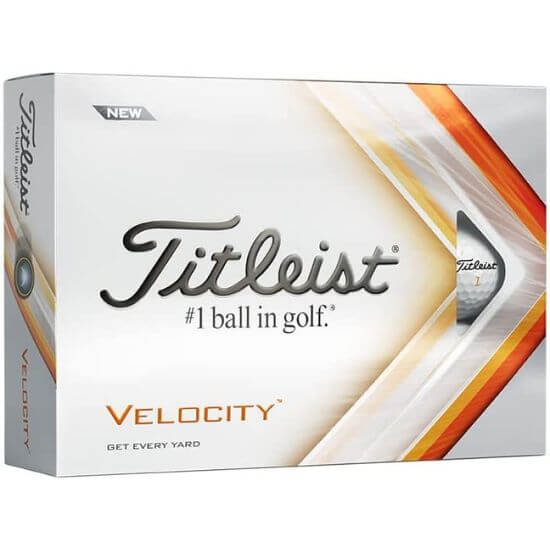
Titleist Velocity is the overall best distance golf ball on our list. It pretty much works for both long and short-game. These golf balls with a combination of comparatively higher compression rate, 2-piece design, and Faster NAZ+ cover give you a bit of both worlds.
Most distance golf balls having less greenside playability, aren’t the best for the short game. That’s natural, as the goal of distance golf balls is to hit longer drives. Titleist Velocity keeps the goal the same and offers good greenside playability too for golfers with a under 100 mph swing speed.
When we compare, Titleist Velocity golf balls don’t provide as much control as Titliest Pro V1 on short-distance shots. So, if your swing speed is more than 100 mph , Pro V1 might be a better choice for more control.
Pros
- You can expect to add 10-20 yards to your drives.
- This ball helps make the shot straighter.
- They go further than Callaway Chrome Soft.
- It generates more speed on full shots.
- Best for low to mid-swing speeds.
- You get a firmer feel.
- The alignment aid on the side is a plus for beginners.
Cons
- The wear may get visible by the 2nd round.
- It isn’t the best choice for shot-shaping.
Final verdict
We chose Titleist Velocity balls as the overall best because they offer a balance of distance and control for golfers under 100 mph swing speed. As you are required to play one hole with one ball only, it’s better to have a good greenside spin to improve the short game along with distance.
2. Callaway Supersoft Max Golf Ball (Best for swing speeds under 80 mph)
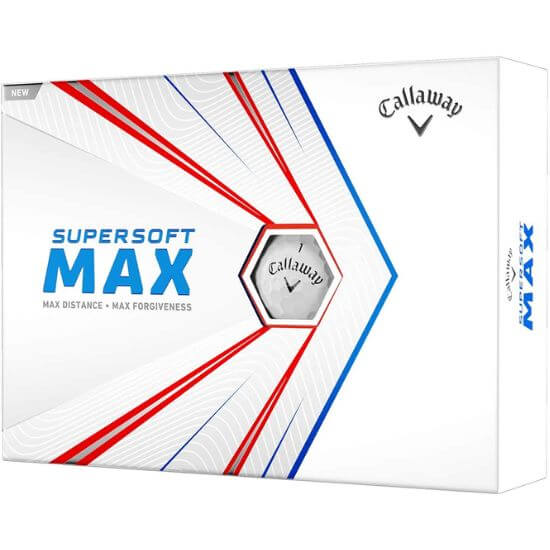
Callaway Supersoft Max balls are larger than Callaway’s Supersoft golf balls. The larger size of Max golf balls is noticeable. They sit better on the turf and are easier to make good contact with. It helps golfers make solid contact. That assists in transferring more energy to the ball and increasing the distance. As the oversized design doesn’t break USGA equipment rules, you can play in any competitive round with these.
Along with its forgiving size, the Tri-Blend Ionomer cover offers low spin. It helps to increase the distance with low swing speeds. This adds extra yards to your drives. Besides, it is one of the lowest compression-rated golf balls, with an ultra-low compression rating under 45. This helps it travel farther than Callaway Erc Soft golf balls with slower swing speeds.
But keep in mind that if you hit it with a swing speed over 85 mph, these golf balls might over-compress. That will make the golf ball lose speed and distance.
Pros
- It’s a suitable option for golfers struggling to make solid contact.
- It offers a higher launch.
- It helps to lessen fades.
- Offers higher flight than Callaway Supersoft.
Cons
- If your shots already go higher, this might decrease the distance.
- These balls are hard to get in and out of some regular golf ball washers.
Final Verdict
Supersoft Max offers forgiveness, higher launch, higher flight, increased ball speed, and distance with slow swing speed. It’s a great option for swing speeds under 80 mph.
3. TaylorMade Tour Response Golf Ball (Best for 80-100 mph swing speeds)
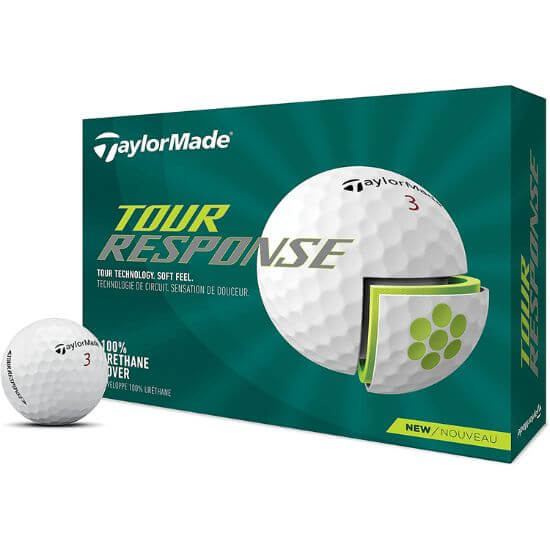
The word ‘tour’ mostly means you get better control and spin with the ball. That also means less distance. So, this TaylorMade golf ball’s name having ‘tour’ word in the title might make many think it isn’t good for distance.
But that’s not always true if your clubhead speed is more than 80 mph. The combination of 70 compression, 3-piece design, and urethane cover helps it to not over-compress. The comparatively lower compression makes it easier to increase the ball’s speed and drive distance. Whereas, 3-piece design and urethane cover combined with the compression provides a tour-like feel without making the drives shorter.
This golf ball’s feel is similar to ProV1. But it’s easier to gain distance with Tour Response for those with swing speeds around 80-100 mph. In addition, Tour Response balls come at a lower price. That makes it more reachable for many golfers.
Pros
- With distance, it offers greenside spin too.
- It offers a soft feel.
- It offers good control with the irons as well.
- The alignment stripe makes it easier to align tee shots and putts.
Cons
- It may get cut from your wedge.
Final verdict
Tour Response is a great choice for golfers with 80-100 mph swing speed. It offers good distance and greenside control to keep your golf score low.
4. Titleist Pro V1 Golf Ball (Best for swing speeds over 100 mph)
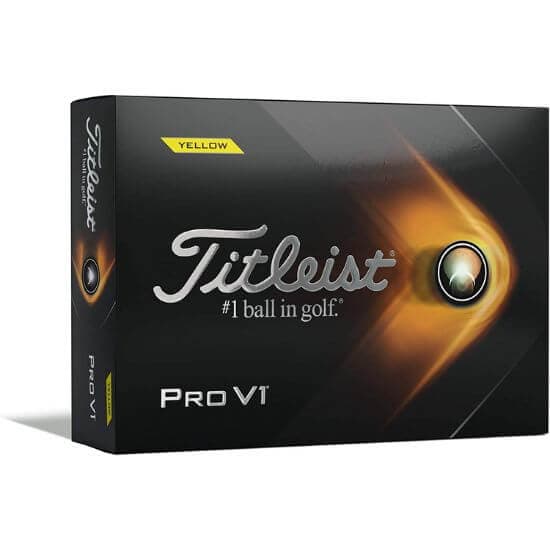
It’s a misconception that premium golf balls are only for best control. They are indeed great for shot-shaping. But they are suitable for distance too when you have a high swing speed.
You may even lose distance if you go for too low compression with high swing speeds. It’s because your strike will over-compress the golf ball and make it lose speed and distance. That’s why we kept Pro V1 in our best golf balls for distance list. It’s for golfers with swing speeds of 100 mph and more.
The 2.0 ZG Process Core helps to increase the distance for golfers with higher swing speeds. While the higher compression and urethane cover offers excellent spin for short game.
Pros
- It goes straighter and further.
- It offers less spin than Titleist Pro V1x, meaning more distance.
- These golf balls offer consistency.
- Comparatively more durable than Callaway Chrome Soft.
Cons
- Not suitable for high handicappers and slow swing speeds.
Final Verdict
If you have a higher swing speed and the budget isn’t an issue for you, Pro V1 is a great option for both distance and control. But for those with 80-100mph swing speed, TaylorMade Tour Response might be a better choice.
5. TaylorMade Distance+ Golf Ball (Best for price)
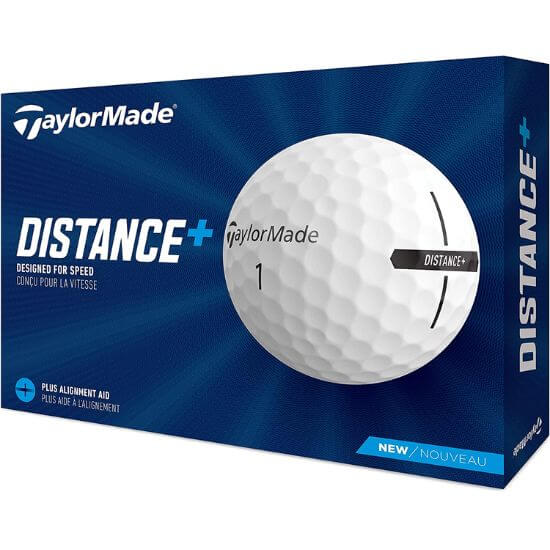
The ‘Distance+’ in the name, makes it obvious that it’s a distance golf ball. While 77 compression may make many think that it won’t be much good for the distance. But the 2-piece construction, the soft REACT™ Core, and the soft ionomer cover make the drives longer by increasing the ball speed.
It comes with an alignment aid too. This helps you strike the golf ball with correct alignment. What makes it more attractive is that it is one of the cheapest golf balls on our best golf balls for distance list. It comes in the same price range as Callaway Warbird. But Distance+ balls are better for practice because of the alignment aid. These are for golfers who lose balls more often or need budget-friendly ones for practice.
If we compare it with other golf balls on our list, it doesn’t provide as much distance as Callaway Supersoft Max Golf Balls with slower swing speeds.
Pros
- It offers a great feel off the tee.
- Goes farther than Titleist Tour Velocity with slow swing speeds.
- These golf balls go straight.
- There is an alignment aid.
- It rolls well on the green.
- Goes 2 rounds easily without much wear and tear.
Cons
- The overall spin performance isn’t the best for short game, especially on wedge shots.
- It’s comparatively less durable.
Final Verdict
This golf ball is neither too soft nor too hard. It assists in making longer drives when golfers with slower swing speeds hit it. It’s a great choice for beginners and senior golfers on a tight budget.
6. WILSON DUO Soft+ Golf Ball
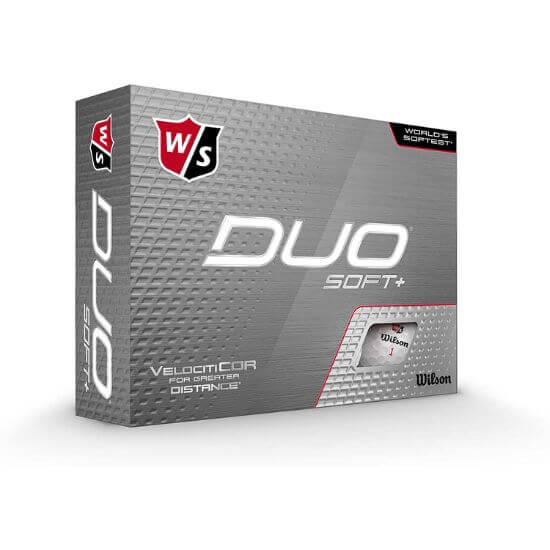
Wilson Duo Soft+ combines 2-piece construction, Ionomer cover, and VelocitiCOR™ that help to add extra yards to your usual shots.
The special core technology of this golf ball helps to transfer all the energy of the swing to shots and enhances them. This increases the golf ball’s speed and makes the golf ball go farther.
When we compare, Wilson Duo Optix also has a combination of an ionomer cover and 2-piece construction. The compression rating is lower too. Both Optix and Soft+ come in the same price range. But if sun glare is an issue for you, Optix might be a better choice.
Pros
- You can expect to add 5-10 yards or more to your drives.
- It helps maintain straight ball flight.
- Offers a great feel with the putter as well.
- Best for golfers under 80 mph swing speed.
- It helps to get a higher launch.
Cons
- Golfers with high swing speed might lose distance with these golf balls.
Final Verdict
DUO Soft+ offers distance, consistency, and good speed with slower swing speeds. The price is pretty reasonable too. But if your swing speed is more than 80mph, TaylorMade Tour Response might be a better option.
7. Srixon Q-Star Tour Golf Ball
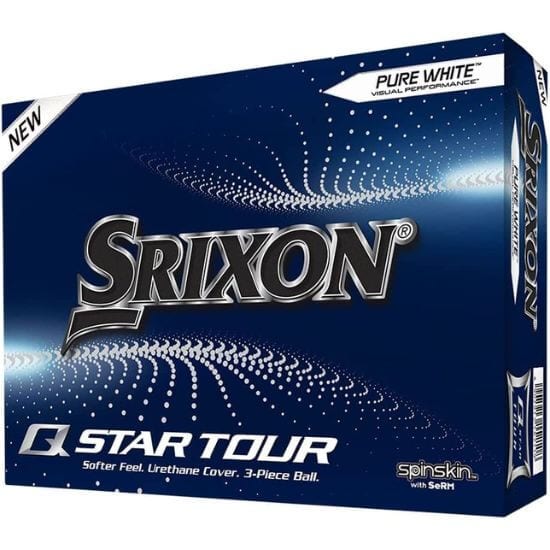
With age, it is natural to lose swing speed. As you might have played with tour balls all your life, switching suddenly to distance balls with too low compression might not feel good when you hit. Q-Star Tour is a solution to this.
The combination of urethane cover and 3-piece construction offers a tour ball-like feel. At the same time, the 72 compression rating helps to make it a good deal for better distance. It can get 10-20 yards extra than ProV1 with a comparatively slower or mid-swing speed. Additionally, you save more than $10 when buying each box compared to ProV1.
Consider that it won’t have the same control as Pro V1 because of the lower compression.
Pros
- It gains more distance than ProV1 with mid-swing speeds.
- It offers a good feel at impact.
- It’s responsive around the green as well.
- The longer side stamp helps in putting alignment.
Cons
- It provides less spin than Pro V1 and ProV1x, especially on approach shots.
Final Verdict
It doesn’t give the same control as Pro V1, nor does it give the distance as Duo soft+ with slow swing speeds. But it’s for the golfers with mid-swing speed looking for a proper balance of distance and control.
8. TaylorMade Keala Golf Ball
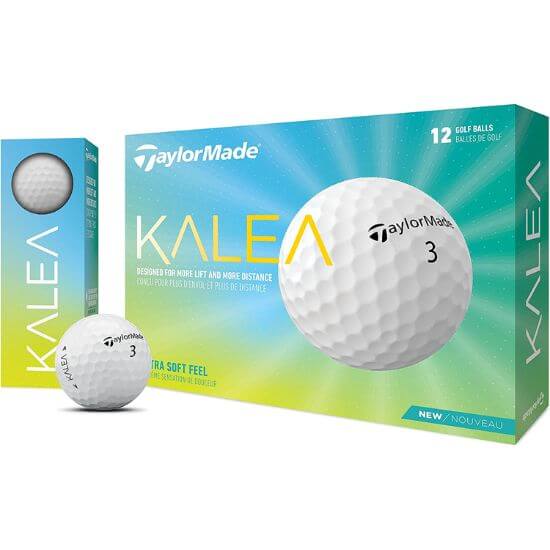
Women golfers naturally have a slower swing speed. So, the golf balls designed for them are engineered to solve this problem. TaylorMade Kalea is one of the best solutions among them.
The 60 compression makes sure that you don’t need to put much pressure while hitting the golf ball. It compresses easily and goes farther than usual. Besides, the 2 layer design and soft ionomer cover enhance the distance and help to give off a good feel.
However, if you have a comparatively higher swing speed, this might not be a good choice to gain distance. For swing speeds over 90 mph, Callaway Chrome Soft might be a better choice.
Pros
- You can expect to add extra 5-15 yards to drives.
- It helps to get a higher launch.
- These balls don’t get damaged much.
- They are suitable for mid to low-swing speed.
Cons
- It offers very little control, especially around the green.
- The purple ones are tough to find on the course.
Final Verdict
Though Callaway advertises Kealea as a women’s golf ball, anyone with a slow swing speed can get a good distance with these, regardless of gender.
9. Callaway Warbird Golf Ball
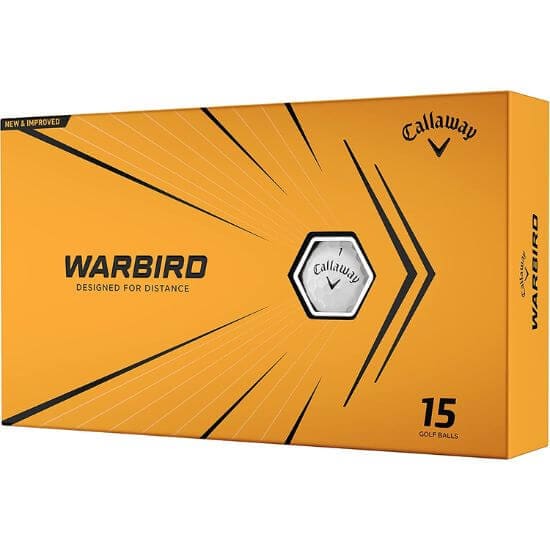
For golfers who lose golf balls quite often, Callaway Warbird is a great choice considering the price. It is comparatively durable as well. It doesn’t get cut easily.
The higher compression rate may make you think that it won’t be easy to get distance with it. But combining a 2-piece design, ionomer cover, and large core altogether increases the speed and distance.
It does give out a good feel and control on the green for slower swing speeds. However, the greenside spin isn’t the best for mid-swing speed, as its overall construction makes it more of a distance ball. Warbird is more suitable for high handicappers with slower swing speeds.
Pros
- It can add 5-15 yards or more to your drives.
- It flies longer than Callaway Chrome Soft.
- It helps to maintain the direction and accuracy of the shots.
- You can use it in all conditions.
Cons
- It feels comparatively firm, especially around the green.
Final Verdict
It’s one of the cheapest golf balls on our best golf ball for distance list. It offers distance, durability, higher launch, and flight to improve your game.
10. Callaway Reva Golf Ball
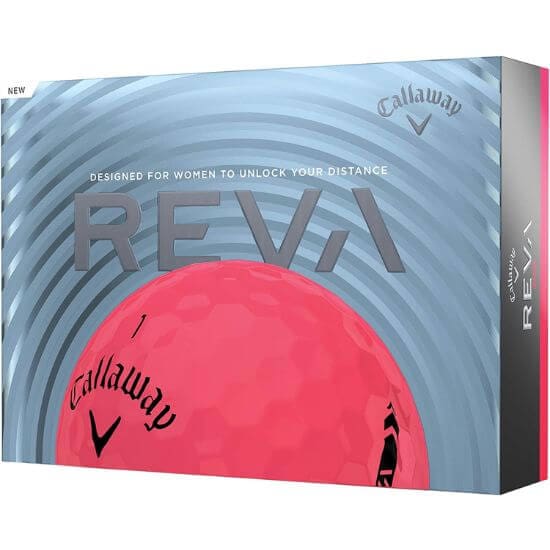
Callaway Reva is often considered the women’s version of the ‘Supersoft Max.’ It’s because of their 0.05 inches larger size. This bigger size of Reva offers a higher center of gravity. That results in better contact with the golf club. And solid contact is the first thing necessary to get better shot results.
These golf balls come with a 2-piece construction and a Tri-blend ionomer cover. This combination makes it spin less, meaning straighter shots because of less side spin. Additionally, you get more roll as the backspin rate is low too.
Supersoft Max and Reva come in the same price range. There aren’t noticeable differences in their performance as well. The difference is in the alignment graphics and color options. Reva has a pink color option, and Supersoft Max gives a yellow option. Both are available in white.
Pros
- It goes farther than Callaway Supersoft.
- It helps to make a solid shot.
- Assists in getting a higher launch.
- It offers forgiveness.
Cons
- It doesn’t fit in some golf cart holders or regular ball washers.
Final Verdict
Callaway Reva is for golfers struggling to make solid contact and distance off the tee. Even if titled as a women’s golf ball, it can be beneficial for any gender’s beginners, seniors, and high handicappers.
Things to Consider When Buying Golf Balls For Distance
Just the compression rate or layers’ number used in construction isn’t enough to consider a golf ball best for distance. A lower compression-rated golf ball may not be a distance golf ball for a slow swinger because of having a 4-5 piece construction, urethane cover, or other design differences. The same ball might be the best golf ball for distance for different golf swing speeds.
So, to find out the best distance ball for yourself, you need to consider swing speed, compression, construction, cover, and dimple, along with the other technologies used to make it. Let’s know about the 6 key factors.
1. Swing speed: Compression, construction, cover choice depends on it
It is essential that you regularly check your swing speed accurately with a golf simulator or swing analyzer. Or you can use the launch monitor of a golf shop. Though you can determine the swing speed without these, it’s better to go with more reliable results while considering the compression, construction, and cover.
It especially goes for beginners and women golfers. As they usually have a slower swing speed, most golf balls designed for them are engineered to aid that way. If your swing speed is comparatively more, then using those women’s or beginners’ golf balls may make you lose distance.
2. Compression: Is lower always better for distance?
As you might already know, a lower compression-rated golf ball needs less swing speed to make it go further. But if the swing speed is too low compared to the compression, the golf ball tends to roll less and cover less distance. The speed decreases too. Thus, it’s better not to go for a much lower compression than your swing speed.
For more distance, it’s usually good to have a compression rate 10-30 numbers lower than your swing speed number in mph. For example, if your swing speed is 90, go for the golf balls with a compression rating from 50-80 for better distance.
3. Construction (Number of pieces)
The fewer pieces on a golf ball, the more distance you get from it, except 1 piece golf ball. It’s because the compression of a 1 piece golf ball is too low. It’s not used for professional games. Because of its low price, many golfers use it for practice. You will mostly find it in driving ranges or mini golf courses.
2-piece and 3-piece golf balls are best for getting more distance with slow swing speed. Here 2-piece construction helps to gain more distance than the 3-piece one. While for those with a swing speed of 105 mph or higher, it is better to go for a 3-piece or 4-piece golf ball to get the most distance.
4. Cover
Golf ball covers are usually made of urethane, surlyn, or ionomer. Urethane covers offer more control, meaning less distance. In comparison, surlyn or ionomer cover gets you extra yards. For golfers with a comparatively slow swing speed, 60-70 mph or less, surlyn or ionomer cover is better. In comparison, urethane is better for those with higher swing speeds.
5. Dimple
Dimples help to cut down the drag and make the golf ball go farther. There are usually 300-500 dimples on the golf ball. The higher number is supposed to make the golf ball go higher. But as most of them have different numbers, shapes, and overall designs, you can’t specifically choose one that promotes distance. Cover, construction and compression is much more important than dimple design. Focus on them more.
6. Price
Golfers buy golf balls more regularly than any other equipment of the golf bag. No matter how much you keep tracking your golf ball or use a golf ball retriever, many golf balls get lost on the course. It isn’t possible to always buy premium golf balls if you lose 2-4 balls daily. That’s why the price is a significant factor.
Distance golf balls with 2-piece construction and Ionomer cover mostly cost less. You can get a dozen of good distance golf balls like Callaway Warbird or TaylorMade Distance+ with $20. At the same time, the best distance golf balls for higher swing speed might cost higher. The price varies depending on the features.
You can use practice golf balls if you want something cheaper. But that won’t make the practice much more effective as they don’t perform like real golf balls.
Frequently Asked Questions
Conclusion
Whether it’s just a fun drive competition among friends or the challenge to break 90, the distance you get off the tee is a major factor in getting a better score. While picking the right golf club comes first. Golf balls can also make a difference in earning extra yardage.
We have discussed the 10 best golf balls for distance in the post, hoping that it will help to find the best one for yourself. Have you used any of these golf balls before? What’s your experience? Feel free to share with us.

